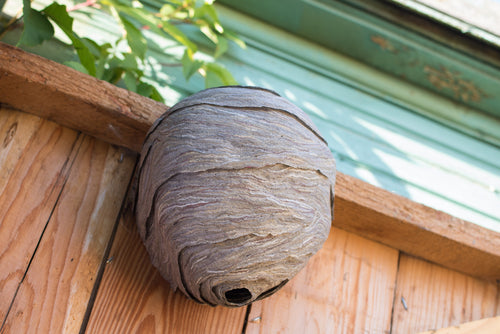
A Guide to Removing a Wasp Nest From a Shed
Wasp nests can sometimes be tricky to identify, and knowing how to remove them safely is essential to avoid injury.
These pests can damage your garden shed and make it impossible to use. If you think wasps are overtaking your shed, follow our easy guide to removing a wasp nest with caution.
You no longer have to worry about incessant buzzing or nasty stings!
How to Spot a Wasps Nest
Wasp nests are typically oval in shape and are often made from chewed wood fibre and saliva, making them appear like paper.
These can range anywhere from a small tennis ball to a basketball, and they are often located on ceilings, tucked into corners, or hidden in the crook of a shed.
To help you spot a wasp nest, look out for grey or brown nests in your shed.
The Necessary Equipment
- Wasp spray
- Flashlight
- Broom or extendable pole
- Sealed plastic bags
- Sealant
- Disinfectant and soap
- Ladder (if necessary)
A Step-by-Step Guide to Removing a Wasp Nest
It's important that you go into this removal process with caution and protection. Wear long-sleeved clothing to prevent injury, and stay calm and collected as you do the following:
- Identify the type of wasp: There are many species of wasps, and some are more dangerous than others. Identify what you're dealing with, or call pest control if you’re unsure.
- Plan your removal: It’s best to remove a wasp nest early in the morning or late at night, as this is when wasps are less active. Choose the best time for you.
- Apply wasp spray: Stand far back from the nest, right next to an exit, and spray the nest with wasp spray. Cover the entire surface and entry points with the spray, and allow it to take effect for a few hours.
- Remove the nest: After a few hours, inspect the nest for wasp activity. If it appears clear, use a long tool, such as a brush or pole, to knock the nest down.
- Dispose of the nest: Once the nest has been knocked down and no wasps are in the shed, place it in a sealed plastic bag and into the bin.
- Clean and seal entry points: Once the nest has been disposed of, clean the area with soap and disinfectant to remove any residual pheromones. Use a sealant to seal any gaps or holes where other wasps could enter.
How to Prevent Wasp Nests in the Future
To avoid having to remove another wasp nest, we’ve compiled a few tips and tricks to keep these buzzing pests at bay:
- Remove food sources: Any leftovers or food packaging should be removed from your shed immediately, as they attract wasps.
- Use essential oils: Oils such as citronella, peppermint, and eucalyptus repel wasps. Mix these with water in a spray bottle and spray it around your shed.
- Plant wasp-repellant plants: Plants such as wormwood and mint repel wasps. Place these around your shed to prevent wasps from entering.
- Add wasp decoys: Use fake wasp nests to deter the real pests, as they tend to avoid areas where wasps are already present. Hang these around your shed.
- Switch shed lights: White lights are attractive to wasps, luring them in. Instead, switch to yellow or sodium vapour lights.
Browse High-Quality Sheds with Atlas Sheds
At Atlas Sheds, we pride ourselves on our vast collection of stunning timber sheds, catering to every need.
From classic storage sheds to luxurious summer houses, you can transform your garden from bland and basic to functional and chic.
Browse our timber sheds today to provide your garden with style and functionality.